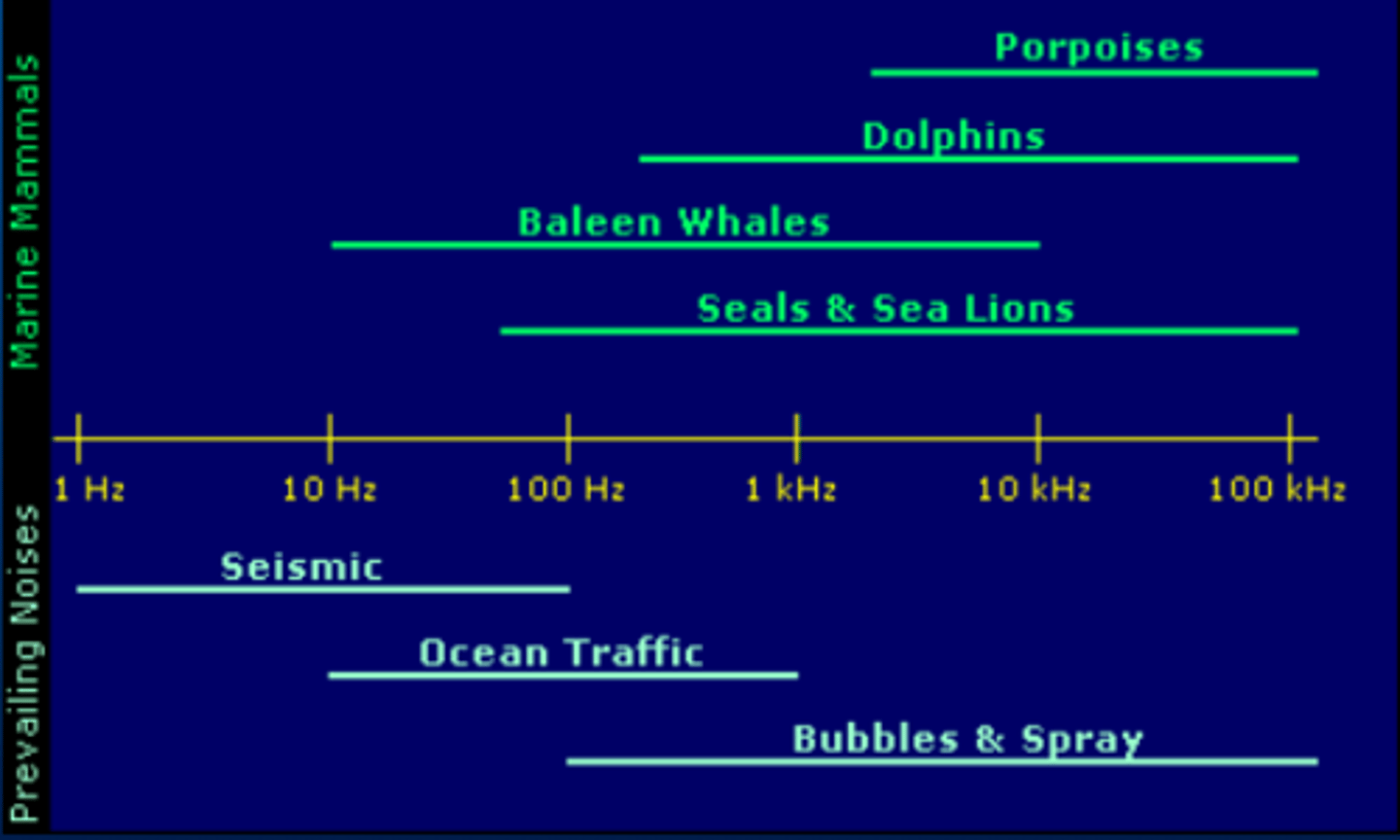Chapter 6: Vocal anatomy, acoustic communication and echolocation
1/40
There's no tags or description
Looks like no tags are added yet.
Name | Mastery | Learn | Test | Matching | Spaced |
|---|
No study sessions yet.
41 Terms
Communication
Acts / structures that affect the behaviour of other organisms and have evolved because of those effects
➢Simple communication: In organisms that lack nervous system, without cognitive abilities, e.g. bacteria
➢Non-informative communication: Lack of cognition, e.g. tungara frogs
➢Passive communication: Swim movements, splashes, exhaling, bubbles, flipper strokes ..
➢Auto-communication: Echolocation
➢Informative communication: Including cognition: alarm calls, waggle dance, language, but also aerial displays like breaching in humpback whales or bubble blowing in bottlenose dolphins ..
Acoustic communication in the sea
Acoustic sensory modality is favoured:
➢Speed of sounds ca 5 times faster than in air, 1500m/s (air 340m/s)
➢Compared to light, which only travels 100m in water - 10km in air
➢Sound travels >100km in water - 1km in air
Sound production marine mammals
Aquatic marine mammals
(cetaceans, sirenians, phocids, walrus) specialised in sound communication & exploration of sea= 2-3 x more auditory versus optic nerve fibres (than land mammals)!
Semi-aquatic marine mammals
(otariids, sea otter, polar bear) communicate mainly in airbut phocids in air and underwater
Larynx
Pinnipeds: well developed Larynx, used for respiration and sound production
Differences between:
➢ Species
➢Males / females ➢Young / older individuals ➢Adaptations for diving

Sound production - larynx
Mysticetes have an unusual laryngeal sac: diverticulum -> resonator for sound production
Odontocetes have a beak like structure -> separated respiratory tract from mouth and oesophagus

Sound production - mysticetes
Skull is modified to accommodate palatal baleen plates as a feeding adaptation
-> Unusual Laryngeal Sac (Diverticulum) & Nasal Passages as Resonator
-> Auditory bullae of Mysticeti are wedged against the skull
-> bone and soft tissue conduction of low-frequency sound
-> Two blow holes

Sound production - dolphin (larynx)
Toothed whales: different than terrestrials – artenoid & eppiglottal cartilages elongated to beak-like structure, which separates respiratory tract from mouth / oesophagus – reduces risk of choking:
-> breath & swallow at same time!
-> Dolphins may produce sounds also in larynx for communication
-> But most Sound Production in nasal passages!
Sound production - odontocetes
➢The skull is shaped to accommodate a melon (or junk in sperm whales), facial muscles, the monkey lips/dorsal bursae (MLDB) complex, and nasal sacs for directional sound generation associated with echolocation and social interaction
➢Only one blow hole
➢The bullae are not fused to the skull but suspended in a spongy mucosa (peribullar plexus) by ligaments - no bone conduction
Sound production - dolphin nasal passage
1) Air is forced between a pair of MLDB - rapidly open and close (vibrate) -> produce sounds (clicks and whistles)
2) The phonic lips are two parallel ridges of transverse, keratinized tissue with fine grooves that direct flow into the vestibular air space for recycling (i.e., not expelled through the nares)
3) Airflow is under voluntarily control - variety of sounds is possible
4) The two MLDBs can function independently -> two different sounds simultaneously (= two voiced calls) Also clicks are produced independently from whistles
5) The melon contains lipids that are impedance-matched to seawater - sounds are produced by air moving past the vibrating monkey lips acoustically separated from melon, which focuses and directs sounds into water Higher frequencies are more focused than lower frequencies!
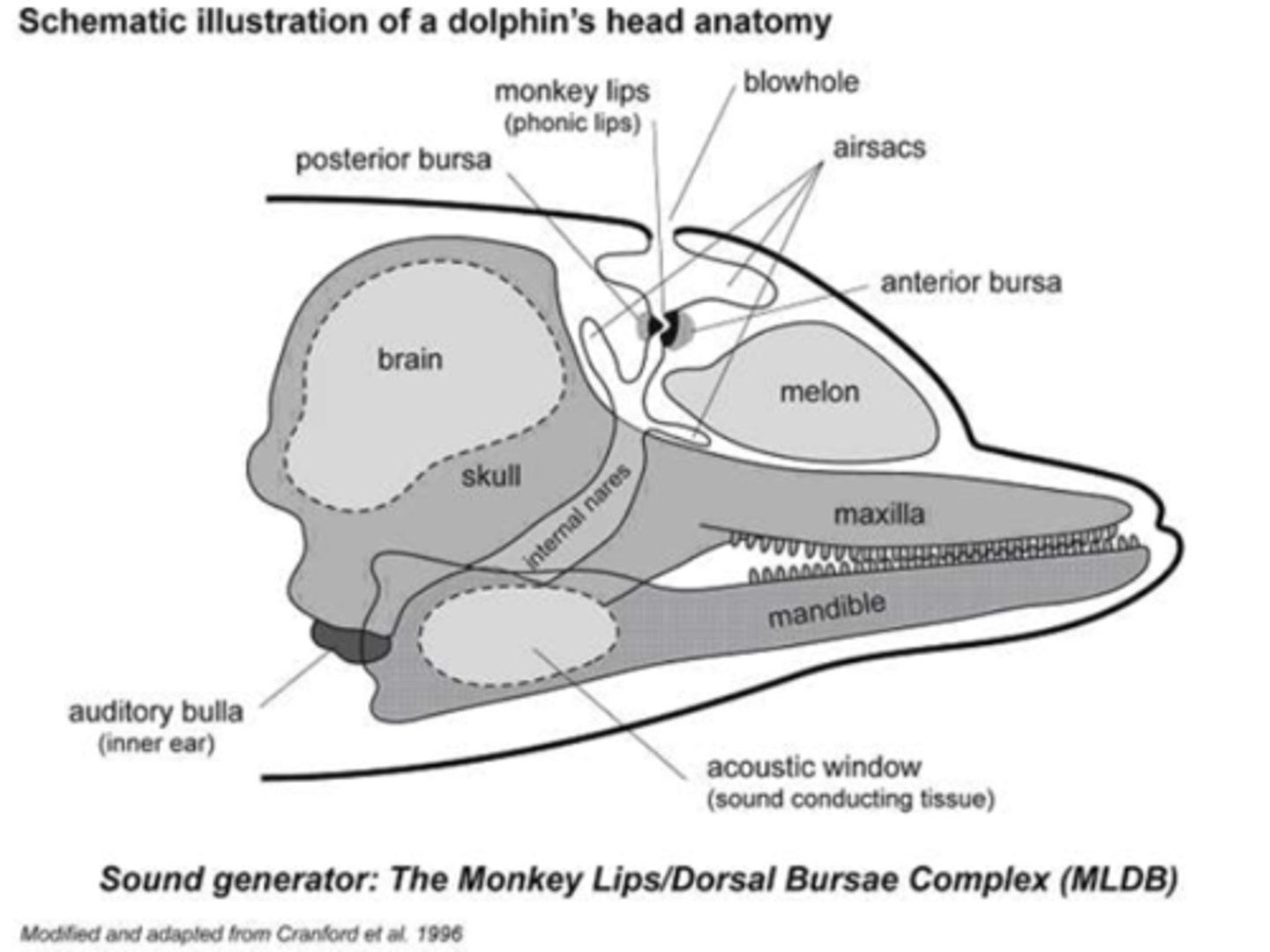
Sound production - spermwhales
Loudest sound in animal kingdom!
-> Junk homologous to melon
-> Spermaceti organ like right posterior dorsal bursa in other Odontoceti
-> Single pair of phonic lips located in right nasal passage beneath blowhole
-> produces high-intensity sonic clicks (400 Hz to 15 kHz and
up to 235 dB re 1 μPa at 1 m)
Clicks several paths in head:
Part of sound - out the front of the head, remainder travels backward through spermaceti organ to air sac adjacent to skull reflected back through the junk - focuses the beam out the front of the head!
-> Part of this sound beam is reflected a 2nd time by distal air sac at front of the head
-> it travels 2nd time to frontal air sac - reflected through junk - out the front of the head!
-> Inter click Interval – Head 1/3 of body length: calculate body size!
Hunting and prey detection, clicks 1–2s intervals
-increase in repetition-> whale approaches potential prey
-> At very close range, repetition rate so fast that individual clicks cannot be distinguished (buzzing), -> “creak”
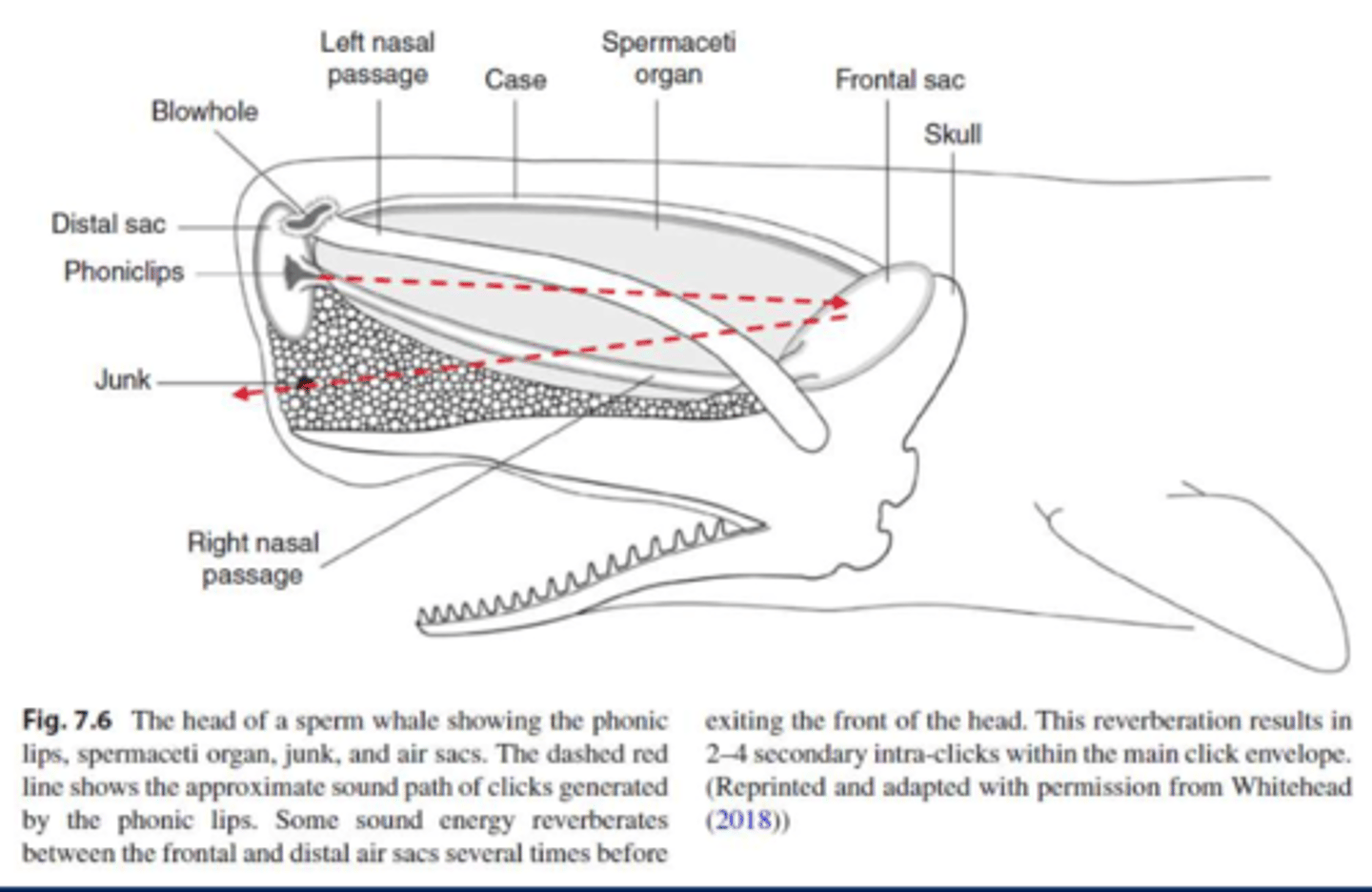
Sound production - pinnipeds
➢vocalizations are sonic, diverse and vary by species, sex, age and season - social communication
➢In Air - often roars, growls, barks, snorts, whimpers, and whistles - exhaling through larynx, vocalizations -> pursed lips or nostrils
➢Underwater vocalizations - moving air between the lungs and pharynx, which causes membranes in trachea to vibrate without expelling air through the mouth or nostrils
Walrus
produces sounds with Lips (whistle/walrus), pharyngeal sac in their necks
Weddel seals
Produce sounds with Tracheal mechanisms, vocal folds
Bearded seals
Produce sounds with Vibration of dorsal tracheal membrane
Ribbon seals
Produce sounds with Air sacs on right side
Hooded seals
Have a inflatable nasal hood and septum (look like a balloon)
-> used for visual and acoustic display
Sound production - sirenians
Vocal folds in larynx -> variety of sonic vocalizations
➢Manatee calls (e.g., chirp-squeaks, squeals, and screams) 0.5-18 kHz, peak frequencies
1-8 kHz
-> Social communication and mother-calf recognition
-> Sounds are acoustically coupled to the water through fat pads in the neck
➢Dugong calls (chirp-squeaks, barks, and trills) frequency range of 2-18 kHz, peak
frequencies of 1-8 kHz
Sound production - sea otter and polar bears
Polar bear: laryngeal mechanisms of terrestrial mammals, lip vibrations - no underwater vocalisations
Sea otters - no underwater vocalisation
➢Aerial vocalizations short-range communication (e.g., screams, whistles, whines, hisses, snarls, coos, grunts, squeals, squeaks)
➢New-born pups routinely - high-frequency cry in distress or seeking attention
-> Adults produce high-intensity long distances (up to 1 km) screams, when distressed or female / pup separated
➢Territorial males produce high-intensity screams when interacting with females!
Echolocation
Auto communication:
➢Signals/sounds are sent out to create anreturning echo from obstacles
- echo is transformed in auditory cortex into map
– information about location, size & composition of environment / prey
➢Mostly high frequency clicks and sweeps
➢Animals explore and orient in dark environment
Echolocation - bottlenose dolphin
➢High frequency clicks (>100 kHz) broad-band (30-40 kHz), high peak (>220dB re 1μ Pa at 1m) short (50-80 μs) ➢Detection range 72 m, detection size 2.5cm
➢Brain is capable of very rapid auditory processing, integrating 0.25 ms interval inputs
➢Inter click interval (ICI) equals round trip & lag time: wait for echo to return & process before emitting new signal
➢Search (ICI) intervals slow and regularly - when closing in on target (ICI) intervals shorter - buzz
➢ICI = RT (round trip click - echo) + LT (lag time / processing time, targets 20-12m -> LT 19-45 ms)
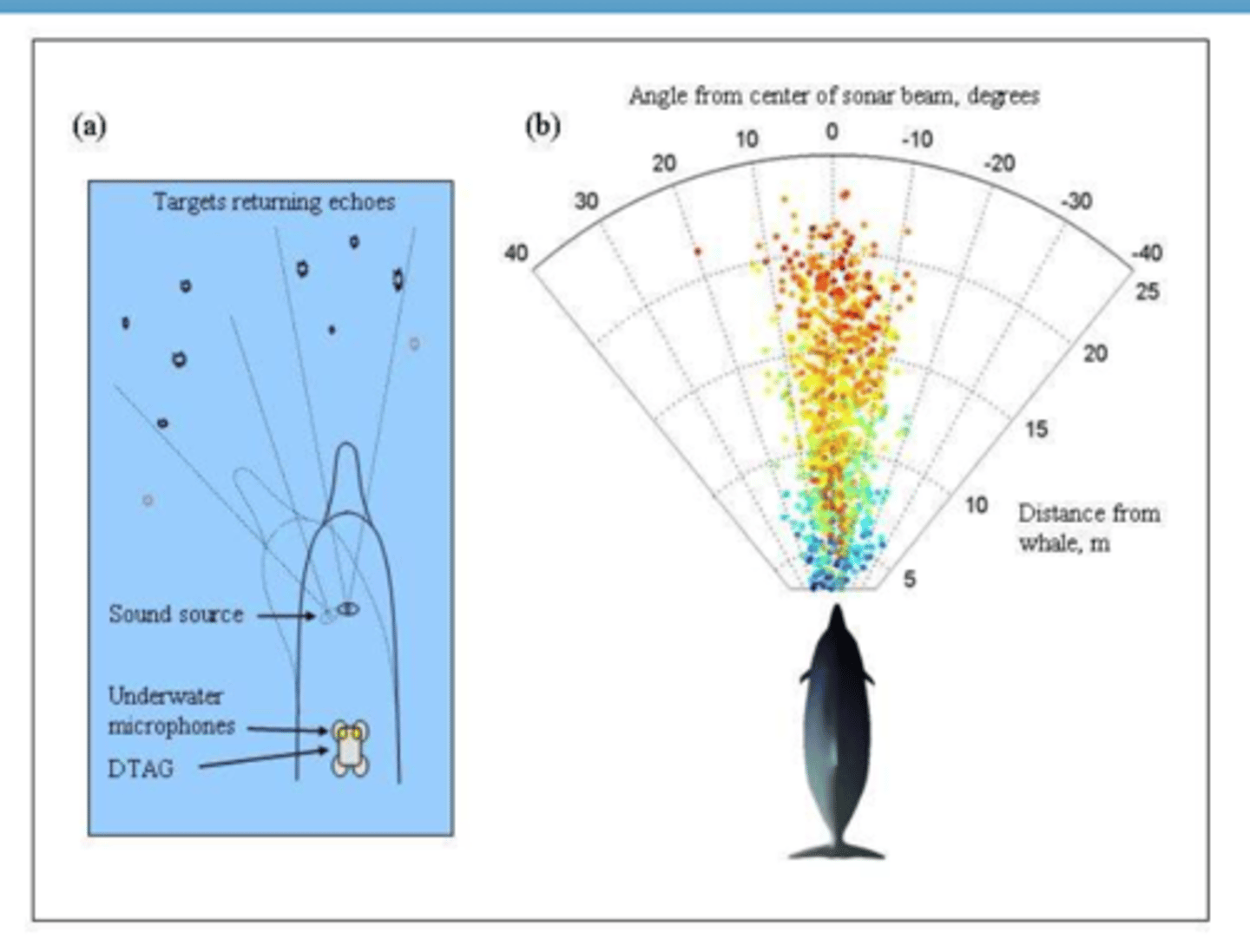
Echolocation - special cases
➢Belugas ICI’s less than return time:process whole click trains in brain
➢Porpoises 5-10 x longer (150-600 μs) but half bandwidth (10-20 kHz), less loud (150-170 dB), very high frequencies (above 100 kHz), inner ears that are specialized for high frequency audition
Echolocation - mysticetes
Bowhead whales use echoes from calls to detect ice obstacle
Vocal repertoire driving factors
➢ Phylogeny, habitat; geographical separation; sexual selection; predator pressure
➢ Social complexity hypothesis of communication
-> group size, social networks and pair bonds in societies
➢ Context: e.g. food association calls: manipulation/arousal/information about food
Vocal repertoire factors in the sea
➢ Habitat: Favourable sound transmission in the sea versus air
-> Speed of sound 1500m/s (340m/s)
-> Transmission loss 60 times less, low light conditions
➢ Echolocation development in toothed whales
➢ Social whales: large & complex group structuresLarge repertories: Signature whistles bottlenose dolphins
-> Complex repertoires: Sperm whale codas
Humpback whale songs , Killer whales dialects
➢ Vocal tradition/culture
From calls to repertoires
➢Vocal classes - spectrogram: Clicks, Pulsed calls, Whistles, other calls distinguished by their frequency harmonics, sidebands, noisy parts etc.
➢Problems with naming - often arbitrary and anthropocentric
➢But vocalisations are context and situation dependent: coarse behavioural categories such as feeding,
socialising, travelling .. Give rough vocalisation patterns - fine scale behaviour needed but difficult to
observe underwater (drones and D-tags give new possibilities)
➢Long distance calls are loud, stereo typed, simple in structure, repetitive and temporally patterned
(rhythm, strong ordering) - low frequency calls of fin whales and blue whales suited to travel thousands of kilometres
➢Short range signals - acoustically more complex, encode information through subtle variations -
multimodal: information to receiver, distance, direction, identity, experience ...
➢Repetition or increased amplitude and frequency against noise
Acoustic structures
Syntactical rules in humpback whale songs
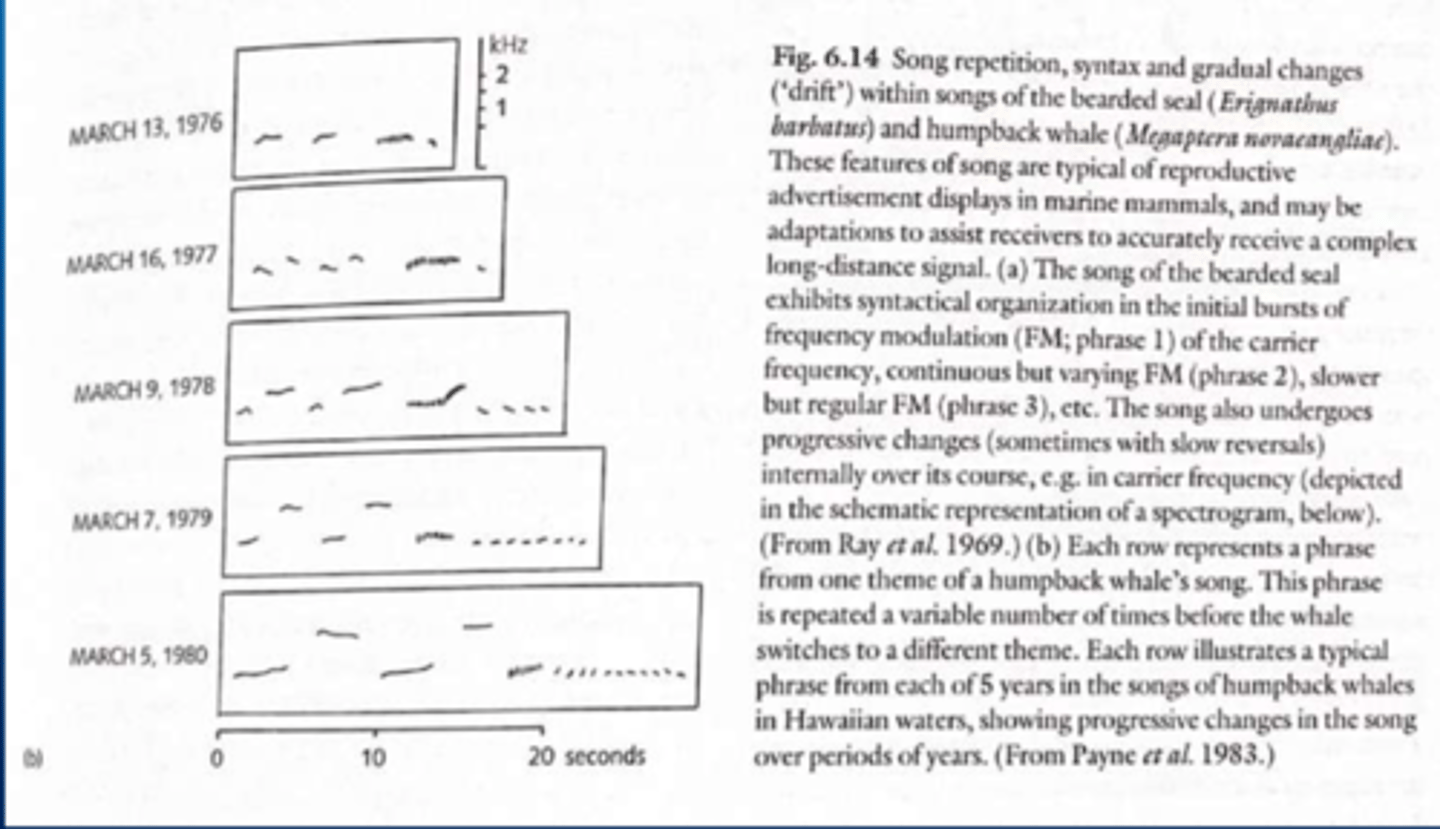
Individual differences in marine mammals vocalisation
➢Differences in vocal tracts lead to vocal differences "voice cues" but underwater high pressure changes vocal signals -> need for vocal control and vocal learning in marine mammals
➢Vocal learning is well documented for odontocetes, mysticetes and pinnipeds
➢But there also differences due to geographical separations, or sex and age related
Vocal repertoires - odontocetes
Produce species-specific, frequency-modulated sonic and ultrasonic sounds such as "whistles" (1-120 kHz), pulsed sounds "calls" (1-60 kHz) and clicks (10-300 kHz) for communication and echolocation
Odontocetes - whistles
➢A) Tonal whistles: variable structures all dolphins
➢B) Stereo-typed whistles: re-occurring stable structure
Bottlenose dolphins, all dolphins
➢C) Ultrasonic Whistles: main energy 20-60 kHz (> 90 kHz) Killer whales and Long-finned pilot whales

Stereo-typed pulsed calls
➢A) Tonal calls, simple to complex calls
➢B) Combination of calls
➢C) Two-voiced calls
➢D) Distinct calls (e.g. signature whistles, dialects)
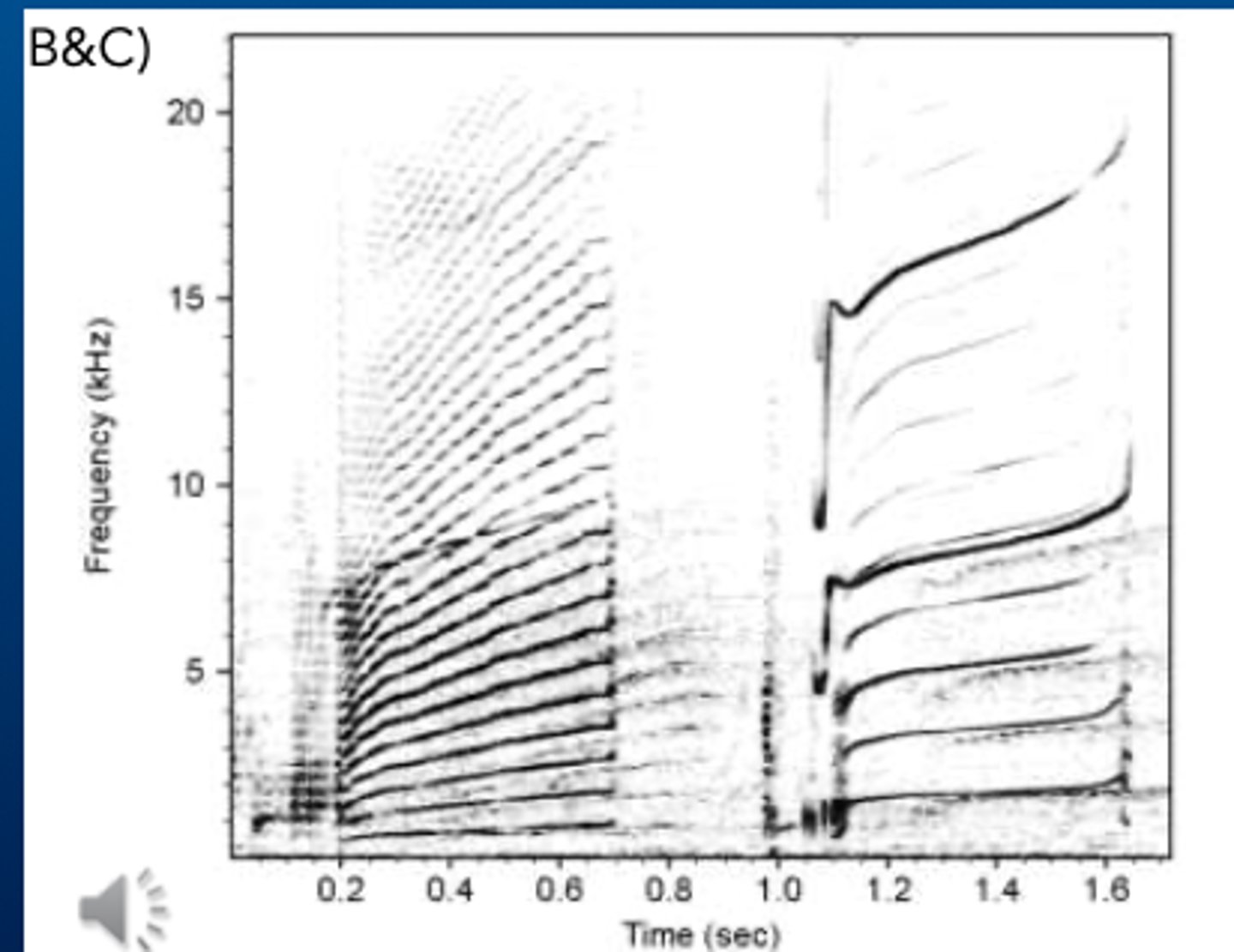
Pulsed calls
➢Variations of calls - graded information may carry information on emotional state, alertness, excitement, hierarchy, danger, food..
➢Other calls without distinct structures such as buzzes, grunts, squeaks....

Combination of calls and other utterances
Calls are often comprised as patterned combinations (Weddel seals, Humpback whale songs, Pilot whales..) & often combined with other displays (e.g. hooded seals, jaw clapping dolphins..)

Clicks
➢Main vocalisation- echolocation- but also communication
-> Buzzes - e.g. killer whales - help to heard herring?- part of calls
➢Not well studied
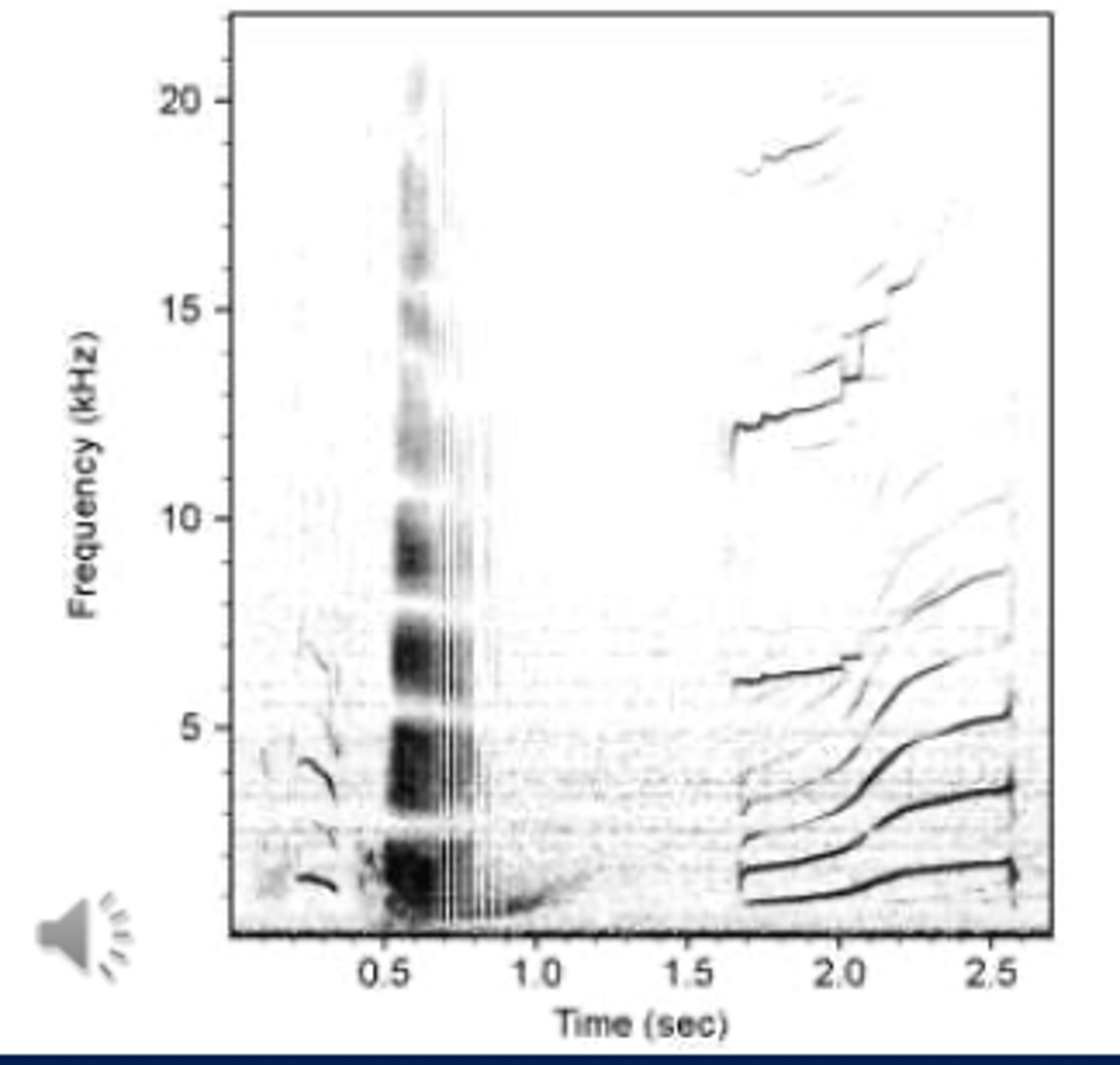
Spermwhale - vocal repertoires
Click communication
-> echolocation clicks
-> clusters of 3-20 clicks called codas - social communication, reflect dialects of female groups
-> Large males make a "slow click" or "clang" to announce themselves to female groups
Vocal repertoires - context
Sperm whale codas - context-sensitive and combinatorial vocalization
- clans have their own set of codasKiller whale group dialects:
-> In Canada, each group has its own call type set, related groups share Call Types
-> avoid inbreeding
Pilot whale group dialects: first results show group specific call types but under investigation
Communication - dolphin groups
Recognition of the individual Signature whistles SW: Bottlenose dolphin signature whistles:
-> New-born learn mothers SW, within 3 months develop their own SW
– announce themselves
– addressed by others
– used in absence of the owner of the SW

Communication - behavioral context
➢Norwegian killer whales: salmon feeding & carousel feeding
➢Icelandic carousel feeding KW similar to Norwegian KW
-> Communicate during hunting and feeding
Mother calf communication
➢Contact calls
➢Distress calls
➢Mother contact call for calves in long-finned pilot whales
Male-male competition - territories
➢Aggressive calls
➢Distress calls
➢Often accompanied with aerial displays such as clapping, inflated hoods, jaw claps etc
Vocal repertoires - mysticetes
They produce a variety of amplitude-and frequency-modulated calls -moans, growls, or simple songs frequency range 7 Hz in the blue whale to 24 kHz in humpback whale songs
Communication – long-distance
Sounds that have wavelength longer than the whale and may be used for long-distance (thousands of km) communication:Fin whale & Blue whale low frequency calls >1000kmSignals are loud, stereotyped, spectrally simple, long, repetitive, and temporally patterned = shaped by sexual selection (complex)
Noise pollution
Most marine mammals only visible 1-10% at surface = acoustic monitoring useful tool to estimate distribution and abundance!
-> Man made noise can interfere and become a problem for marine mammals (e.g. Richardson et al, 1995) Past 50 years noise in Ocean 20 X increase!
